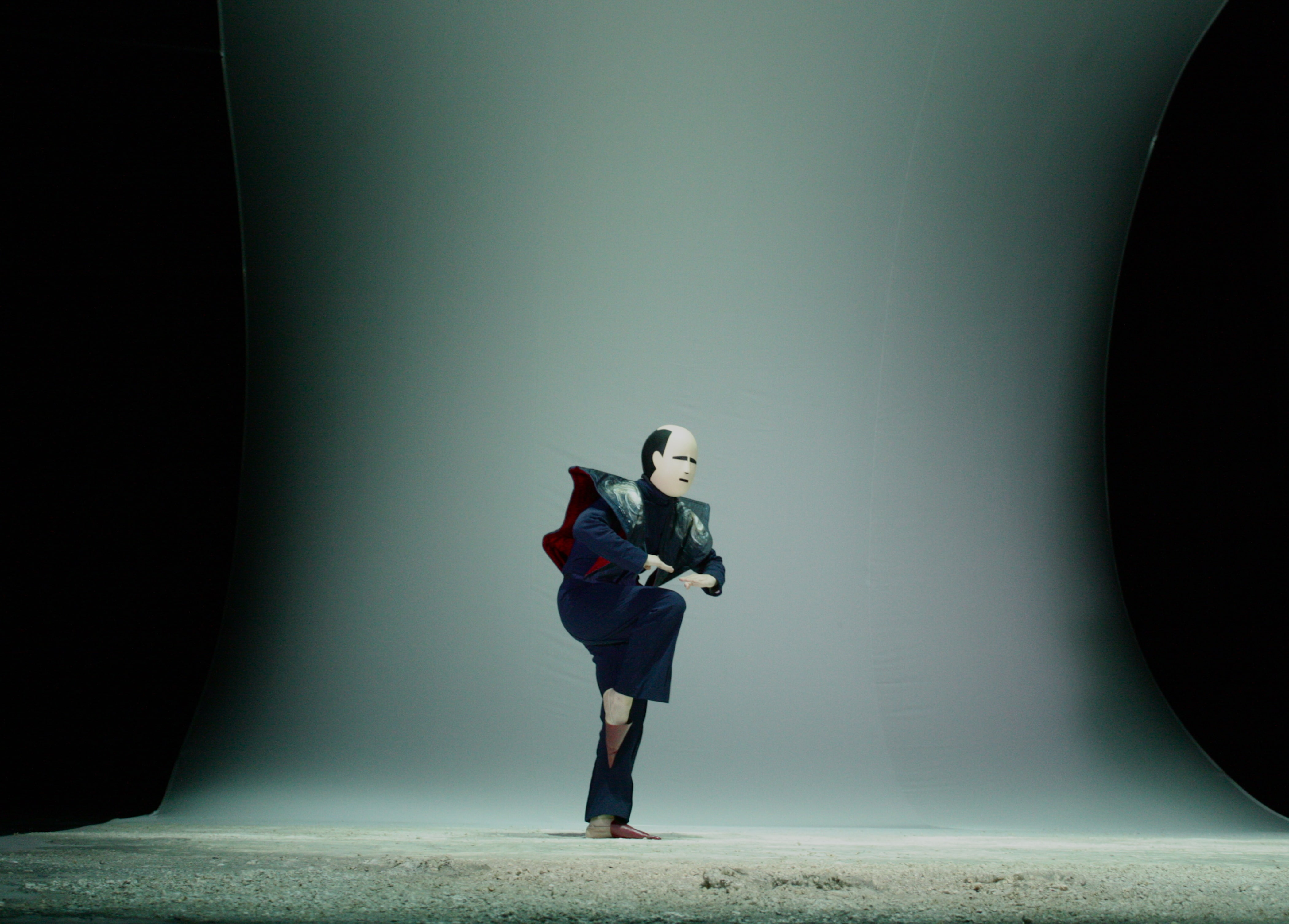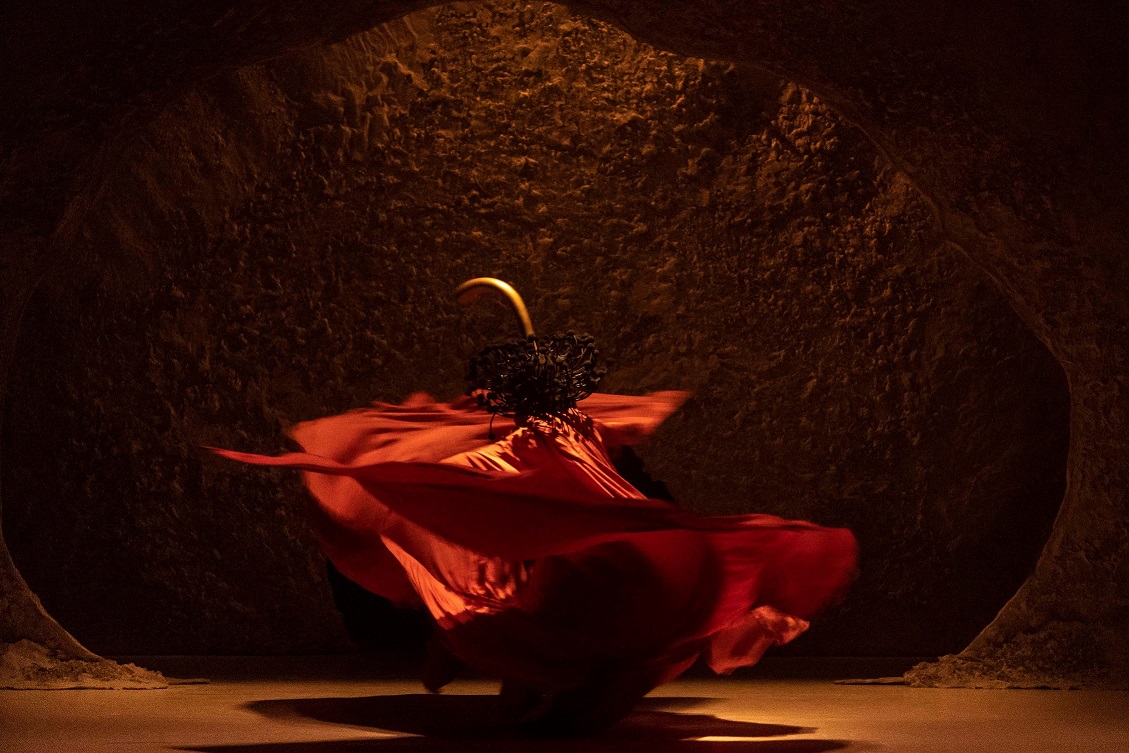Dewey Dell è una compagnia di danza e performing arts italiana attiva dal 2006 e ora composta da Agata Castellucci, Teodora Castellucci, Vito Matera e dal musicista Demetrio Castellucci.
La ricerca coreografica, spesso ispirata dalle immagini della storia dell’arte e dai comportamenti del regno animale, ha intrapreso un percorso di confronto sfrontato con archetipi e telai narrativi tratti dall’antichità. La volontà è quella di trasformare il modello antico in un calco per il riversarsi di una sostanza attuale e nuova.
Dewey Dell ha creato lavori di danza che intersecano forme d’arte diverse, portando avanti linee di sperimentazione nella performance musicale, nella video art e nell’arte visiva.
Dewey Dell nei suoi lavori ha collaborato con numerosə artistə tra cui il fumettista Yuichi Yokoyama, il direttore teatrale Kuro Tanino, la graphic designer Clio Casadei, il musicista Massimo Pupillo (Zu) , il vocalist Attila Chsihar (Mayhem), lo scultore Matteo Lucca, il collettivo di installazioni audiovisive Transforma. Nel 2023 la compagnia ha creato le coreografie per l’opera lirica “Macbeth” di Giuseppe Verdi, presentata all’Aalto Theatre di Essen in Germania, sotto la regia di Emily Hehl.
Da venti anni Dewey Dell produce numerosi lavori, tra questi lo spettacolo “Sleep Technique – A Response to the Chauvet Pont d’Arc Cave” (2017) è stato nominato per la coreografia al prestigioso Der Faust Theaterpreis in Germania, “Le Sacre du Printemps” (2023) ha vinto il premio DANZA&DANZA come “produzione italiana” del 2023.
Gli spettacoli sono stati presentati in tutto il mondo e in contesti molto diversi tra loro: Arts House e Melbourne festival in Australia, Rencontres chorégraphiques internationales de Seine-Saint-Denis e Palais de Tokyo a Parigi, La Biennale Danza di Venezia, Wesleyan University e Macalester College negli USA, Southbank Centre and Mime Festival al Barbican di Londra, Cabaret Voltaire a Zurigo, Seoul International Dance Festival in Seoul, A l’Arme Festival a Berlino, Steirischer Herbst a Graz, BIT Teatergarasjen a Bergen, Save Party/Arma 17 a Mosca e il Khidi a Tbilisi per nominarne alcuni.
Dewey Dell is an Italian dance and performing arts group active since 2006 and now composed by Agata Castellucci, Teodora Castellucci, Vito Matera, and the musician Demetrio Castellucci.
The choreographic research - continuously inspired and nourished by the images of art history and the behaviors of the animal kingdom - brings forward its own path of bold confrontation with archetypes and narrative frames drawn from the ancient world, with the intention of turning the model into a cast for pouring out a current and new essence.
Dewey Dell has created dance works that intersect different art forms, pursuing other lines of experimentation in music performance, video and visual art.
Over the years Dewey Dell has collaborated with different artists such as visual artist Yuichi Yokoyama, theater director Kuro Tanino, graphic designer Clio Casadei, musician Massimo Pupillo (Zu), vocalist Attila Chsihar (Mayhem), sculptor Matteo Lucca and audiovisual installation collective Transforma among others. In 2023 the company curated the choreography for the opera “Macbeth” by Giuseppe Verdi, directed by Emily Hehl and presented at Aalto Theatre in Essen.
Since 2006 Dewey Dell has created many works, in particular the show “Sleep Technique – A Response to the Chauvet Pont d’Arc Cave” (2017) has been nominated at the prestigious German prize Der Faust Theaterpreis for the choreography and “Le Sacre du Printemps” (2023) won the Danza&Danza award as the best Italian dance production in 2023.
Their works have been presented all over the world within different contexts: Arts House and Melbourne festival in Australia, Rencontres chorégraphiques internationales de Seine-Saint-Denis and Palais de Tokyo in Paris, La Biennale Danza in Venezia, Wesleyan University and Macalester College in the US, Southbank Centre and Mime Festival at the Barbican in London, Cabaret Voltaire in Zurich, Seoul International Dance Festival in Seoul, A l’Arme Festival in Berlin, Steirischer Herbst in Graz, BIT Teatergarasjen in Bergen, Save Party/Arma 17 in Moscow and Khidi Club in Tbilisi among others.
In ogni metamorfosi e grande cambiamento dell’essere umano, la morte è sempre al fianco della vita, manifestandosi come un rito di passaggio o di rivoluzione interiore. Nel mondo animale e vegetale la compresenza di vita e morte diviene ancora più letterale; spesso la morte fa parte del processo fecondativo, e la vita pullula sulle carcasse decomposte. Soprattutto nel mondo degli insetti, dei semi e delle muffe la morte è una presenza espansa: la morte è un invito alla vita. La rigenerazione ciclica delle stagioni e della fecondità della terra non sono un percorso lineare, ma lo sconquasso di tutti gli elementi. La primavera è il periodo di massimo turbamento e il terrore dell'esistenza si fonde alla gioia vertiginosa dell’esserci.
Foto di Lorenza Daverio per Triennale Milano
Musica originale Igor Stravinskij, eseguita da MusicAeterna diretta da Teodor Currentzis (2013)
Concept e regia Dewey Dell
Coreografia Teodora Castellucci
Assistenza alla coreografia e produzione Agata Castellucci
Drammaturgia, disegno luci e scena Vito Matera
Suoni Demetrio Castellucci
Costumi Dewey Dell, Guoda Jaruševičiūtė
Documentazione video Eva Castellucci, John Nguyen
Original music Igor Stravinskyj performed by MusicAeterna conducted by Teodor Currentzis (2013)
Concept, direction Dewey Dell
Choreography Teodora Castellucci
Choreography assistance, production Agata Castellucci
Drama, light and stage design Vito Matera
Sounds Demetrio Castellucci
Costume design Dewey Dell, Guoda Jaruševičiūtė
Video documentation Eva Castellucci, John Nguyen
In every metamorphosis and profound change of a human life, death is always by the side of life, appearing as a rite of passage or as an inward revolution. In the animal and plant kingdom the coexistence of life and death becomes even more literal: death is often part of the fecundation process and life swarms on decomposed carcasses. Especially among insects, seeds, and molds, death is a welcoming presence; death is an invitation to life. The cyclic regeneration of the seasons and of the fertility of the soil are not a linear journey, but a chaotic disruption of all the elements together. Spring is a time of great agitation and the terror of existing is forever blended with the sidereal joy of being.
Photo by Lorenza Daverio per Triennale Milano
REGNO UNITO - CANTERBURY, GULBENKIAN ARTS CENTRE - 29 SETTEMBRE 2023
NORVEGIA - BERGEN, METEOR FESTIVAL, STUDIO USF - 27 e 28 OTTOBRE 2023
UNITED KINGDOM - CANTERBURY, GULBENKIAN ARTS CENTRE - SEPTEMBER 29TH 2023
NORWAY - BERGEN, METEOR FESTIVAL, STUDIO USF - OCTOBER 27TH and 28TH 2023
La solitudine è un aspetto costituente del mestiere del pastore. Gli permette un’immersione interiore totale, un lieve allontanamento dal visibile. I suoni udibili si assorbono in un nuovo silenzio, i pensieri si formano in modo assoluto. Gli animali da custodire diventano l’unica possibilità di astrazione dal sé, di cura o di affetto. Quando i pastori cantano, per intonarsi imitano il vento o il belato della pecora o della mucca. E attraverso la poesia cantata trasmettono una storia passata, tramandando la cultura in modo orale generazione dopo generazione.
La risalita lungo il tempo però non abbandona la realtà attuale, si distacca solo dal mondo visibile.
La storia che i pastori poeti cantano si potrebbe intendere come un tentativo di decifrazione dell’invisibile, che avviene attraverso una discesa nel sé, una geografia del soprannaturale.
Foto di Salvatore Laurenzana
Coreografia Teodora Castellucci
Musiche Demetrio Castellucci
Assistenza alla coreografia Agata Castellucci
Composizione corale, voci Adam Sherry e Sam Sherry / A Dead Forest Index
Drammaturgia Vito Matera
Costumi Guoda Jaruseviciute
Choreography Teodora Castellucci
Music Demetrio Castellucci
Assistant to choreography Agata Castellucci
Choral composition, voices Adam Sherry and Sam Sherry / A Dead Forest Index
Dramaturgy Vito Matera
Costumes Guoda Jaruseviciute
The solitude of the shepherds is a constituent aspect of their work. Solitude allows a profound immersion into the self, a delicate movement away from the visible. Sounds become absorbed into the silence, thoughts swell freely inside the mind. The animals being guarded are the only possibility to abstract yourself, to address your attention to. When shepherds sing they use the wind, the bleating of the sheep or the bellow of the cow to tune themselves. Through singing poetry, the shepherds pass down history orally, generation after generation.
The resurgence of time though, does not forget the actual reality, it just moves away from the visible world again.
The story that the shepherds sing could be interpreted as an attempt to decipher the invisible, possible only through a descent into the self, a geography of the supernatural.
Photo by Salvatore Laurenzana
REGNO UNITO - CANTERBURY, GULBENKIAN ARTS CENTRE - 28 SETTEMBRE 2023
UNITED KINGDOM - CANTERBURY, GULBENKIAN ARTS CENTRE - SEPTEMBER 28TH 2023




